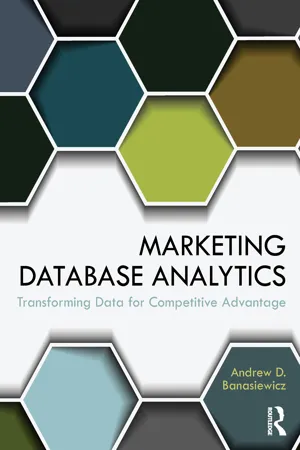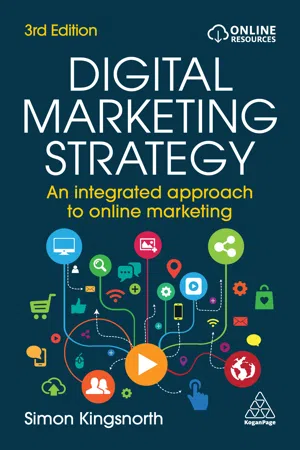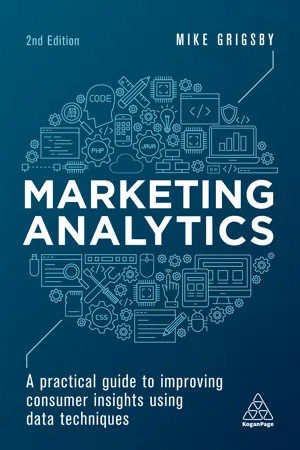Marketing
Marketing Analytics
Marketing analytics involves the use of data and statistical analysis to evaluate marketing performance and optimize strategies. It encompasses the measurement and interpretation of various marketing metrics to gain insights into customer behavior, campaign effectiveness, and return on investment. By leveraging marketing analytics, businesses can make data-driven decisions to enhance their marketing efforts and achieve better results.
Written by Perlego with AI-assistance
6 Key excerpts on "Marketing Analytics"
Learn about this page
Index pages curate the most relevant extracts from our library of academic textbooks. They’ve been created using an in-house natural language model (NLM), each adding context and meaning to key research topics.
- eBook - ePub
Marketing Database Analytics
Transforming Data for Competitive Advantage
- Andrew D. Banasiewicz(Author)
- 2013(Publication Date)
- Routledge(Publisher)
Direct marketing. The basic design, fielding, tracking and measurement techniques.Experience-Based Knowledge
• Promotion analytics “rules of thumb.” Is 20% a reasonable campaign response rate to a repurchase campaign targeting lapsed brand buyers? Sometimes, to be able to pinpoint a truly successful result or a finding that falls outside what is normally considered to be a “reasonable” range, an investigator needs to have some degree of familiarity with “typical” or “normal” values for given outcomes.Why is it important for a data analyst to develop such a wide-ranging set of skills and proficiencies? The short answer to this question is because all of those factors play a role in transforming generic information into unique, competitively advantageous knowledge. More on that in the next section.The Marketing Database Analytics Process
As convincingly argued by Peter Drucker, one of the most preeminent management thinkers, a business enterprise ultimately just has one goal—to create a customer. Doing so requires management to perform two critical functions in every organization: 1. to foster innovation, and 2. to effectively market the organization's products and/or services. Management teams that perform these two tasks better than their competitors will win a larger share of the overall customer base.It follows from the above rationale that effective promoting (of products or services) entails using the least amount of resources to win the largest number of customers. This intuitively obvious notion is at the root of what is generally referred to as “promotional productivity,” often objectified through the promotional ROI (return on investment) metric. - eBook - ePub
Digital Marketing Strategy
An Integrated Approach to Online Marketing
- Simon Kingsnorth(Author)
- 2022(Publication Date)
- Kogan Page(Publisher)
20Measuring success through data analytics and reporting
What we will cover in this chapter
This chapter covers how to build effective measures for digital marketing success, the tools needed to track your achievements and how to communicate them consistently as part of the story of your digital strategy. The key areas covered in this chapter are:- The data landscape
- The reliability of data-based decisions
- What are analytics?
- Tools and technology
- Attribution modelling
- Reporting
CHAPTER GOALSBy the end of this chapter you should understand the importance of analytics and key techniques in developing your reporting structure. You should understand attribution modelling and have an appreciation of data-based decision reliability. You will understand tag- and server-based analytics as well as social and web analytics.The data landscape
The final part of developing your strategy is also quite possibly the most important. Delivering a strategy that is not effectively measured can create confusion or a lack of transparency that is impossible to come back from. In other words, if your strategy is set in motion but you cannot prove that it is delivering any results then it can quickly receive negative feedback from your internal stakeholders and can even be cancelled by your decision makers. If your goals cannot be demonstrably met, how will you or, perhaps more importantly, your stakeholders ever know if your strategy has been a success or how to adapt it going forwards? Everything before this point becomes utterly meaningless without ensuring that your analysis is implemented correctly and is future proofed as much as possible.Digital marketers are fortunate (and some may say also unfortunate) to have endless tools and data at their disposal to enable full transparency. The challenges here are, therefore, not the limits of technology or visibility, but in the strategic implementation and reporting of the data that is outputted. Understanding how best to use this data and how to fit the pieces of disparate information together to form solid insights is an art form as much as a science. - eBook - ePub
- Eric C. Schwarz, Jason D. Hunter(Authors)
- 2017(Publication Date)
- Routledge(Publisher)
Whereas metrics are the measures of performance, analytics are the tools and the data needed to produce metrics. Analytics is a systematic computational analysis of historical data to forecast potential trends, evaluate the effect of sport marketing decisions and related events, and examine sport marketing performance. The statistics needed to input into sport marketing metrics can be easily found using a multitude of web analytics tools on the market – one of the most popular is Google Analytics. However, what is driving the rise of analytics in sport marketing are the concepts of small and big data and the ways in which that information is analyzed.Small and big data analysis
Two terms that are commonly spoken about with relation to analytics are small data and big data. The term small data usually refers to statistics and information utilized by people in a form that is accessible, actionable, and informative. Small data can be calculated using common data software programs and statistical analysis using qualitative or quantitative analysis. From a sport marketing perspective, small data are the information collected through the various market research methods discussed in Chapter 4 . On the other hand, big data is a much more complex concept and usually cannot be calculated easily by people or traditional data processing software. Big data usually focus on the use of predictive analytics and user behavioral analytics to find correlations. Predictive analytics involves analyzing current and historical facts through predictive modeling and data mining – the latter being one area where sport marketing professionals engage in the use of big data. User behavior analytics is more used in the financial and cyber security realms to detect insider threats, financial fraud, and cyber attacks.The use of small data has been a staple in sport marketing for decades; however, the advances in technology have now made big data accessible to sport marketing professionals and sport organizations. Big data can assist sport marketing professionals to leverage the latest techniques to collect and evaluate data about existing and potential customers. It also allows for creating more robust marketing profiles about customers, clients, and channels. In terms of channels, sport Marketing Analytics provides information that can assist in marketing products and services across multiple and diverse channels. - eBook - ePub
Win with Advanced Business Analytics
Creating Business Value from Your Data
- Jean-Paul Isson, Jesse Harriott(Authors)
- 2012(Publication Date)
- Wiley(Publisher)
- Merely capturing customer information is not sufficient; what will differentiate a company from its competition is its ability to transform data from information into actionable predictive analytics. Successful companies are those that will leverage the power of advanced analytics to predict outcomes and scenarios for their business objectives to drive sales marketing and services activities.
- Predictive analytics is made up of three major stages: unlocking, prediction, optimization. Predictive analytics is about unlocking patterns and trends from big data, predicting the future of an outcome or an event, and optimizing business actions.
- We also introduced examples of how predictive analytics are applied, including an example from telecommunications using customer lifetime value.
FURTHER READING
Lindoff, Gordon, and Michael J. A. Berry. Data Mining Techniques: For Marketing, Sales, and Customer Relationship (Indianapolis, IN: Wiley Publishing, 2011).Olivia Par Rud. Data Mining Cook Book: Modeling Data for Marketing, Risk and Customer Relationship Management (New York: John Wiley & Sons, 2000).NOTES1 . “Data, Data Everywhere,” Economist , February 2010, http://www.economist.com/node/15557443 .2 . “Handling the Cornucopia,” Economist , February 2010, http://www.economist.com/node/15557507 .3 . James Kobielus, The Forrester Wave™: Predictive Analytics and Data Mining Solutions, 2010,” Business Process & Applications Professionals, February 4, 2010.)4 . Raymond Paquet, “Technology Trends You Can’t Afford to Ignore,” Gartner, January 2010, http://www.gartner.com/it/content/1258400/1258425/january_6_techtrends_rpaquet.pdf .5 . “Modelling Behaviour: Game Theory in Practice,” Economist , September 3, 2011, http://www.economist.com/node/21527025 .* - eBook - ePub
Marketing Analytics
A Practical Guide to Improving Consumer Insights Using Data Techniques
- Mike Grigsby(Author)
- 2018(Publication Date)
- Kogan Page(Publisher)
As alluded to above, marketing science is the analytic arm of marketing. Marketing science (interchangeable with Marketing Analytics) seeks to quantify causality. Marketing science is not an oxymoron (like military intelligence, happily married or jumbo shrimp) but is a necessary (although not sufficient) part of marketing strategy. It is more than simply designing campaign test cells. Its overall purpose is to decrease the chance of marketers making a wrong decision. It cannot replace managerial judgement, but it can offer boundaries and guard rails to inform strategic decisions. It encompasses areas from marketing research all the way to database marketing.Why is marketing science important?
Marketing science quantifies the causality of consumer behaviour. If you don’t know already, consumer behaviour is the centre-point, the hub, the pivot around which all marketing hinges. Any ‘marketing’ that is not about consumer behaviour (understanding it, incentivizing it, changing it, etc) is probably heading down the wrong road.Marketing science gives input/information to the organization. This information is necessary for the very survival of the firm. Much like an organism requires information from its environment in order to change, adapt and evolve, an organization needs to know how its operating environment changes. To not collect and act and evolve based on this information would be death. To survive, for both the organization and the organism, insights (from data) are required. Yes, this is reasoning by analogy but you see what I mean.Marketing science teases out strategy. Unless you know what causes what, you will not know which lever to pull. Marketing science tells you, for instance, that this segment is sensitive to price, this cohort prefers this marcom (marketing communication) vehicle, this group is under competitive pressure, this population is not loyal, and so on. Knowing which lever to pull (by different consumer groups) allows optimization of your portfolio. - eBook - ePub
Inbound marketing
Just round the Corner Deals await you
- Chandranai, (Authors)
- 2018(Publication Date)
- BPB Publications(Publisher)
Metrics for this could be somewhere around two thousand visitors. Of these thousand would be attracted by social media campaign, five hundred through emails and remaining five hundred byusing offline marketing.PRESENTATION OF ANALYTICS
It is not a very wise decision to create a report that comprises of thick bundles of paper. No one has the time to go through all that. The best way is to create Dashboards and Graphs which are capable of conveying more information in less words.The reports should be able to display the inconsistencies in the marketing business strategies.SHARING ANALYTIC RESULTS
It is a good practice to share the analytic reports with all those people who need such report specially the management of the company who may use these reports to take a decision. Reports should have enough information which is necessary for that person to know about.NoteOne can develop a plan to remove the gaps in the inbound marketing plan, but planning is not the only thing. One needs to actually implement this plan. In order to do this there needs to be a timeline according to which it has to be implemented. Also metrics and milestones need to be decided and outcome of the efforts need to be continuously analyzed against them. The results of these analyses need to be presented in form of dashboards shared with all people who may need this information to take strategic business decisions.ActivitySuppose you are running a kitchen electric items marketing business and have found certain problems in your inbound marketing e.g. lead conversion is very low. Devise a plan to rectify this problem.ASSESSMENT QUESTIONS
1. The best way is to create presentation of analytics is __________and graphs which convey more in less words. 2. The ________________ of inbound marketing have to be divided.FILL IN THE BLANKS2.4 SUMMARY
Like every other business process, it is important to continuously monitor the various phases of inbound marketing. Monitoring helps to find the gaps in performance and take remedial measures. Metrics and Milestones are identified to measure the performance. KPI are such metrics which help in the purpose. Some of the commonly used KPIs for inbound marketing are Sales Revenues, Customer Acquisition Costs (CAC), Customer Lifetime Value (CLV or CLTV), Inbound Marketing Return On Investment (ROI), Unique Website traffic, Quality Marketing Leads generated, traffic, leads and conversion rate by source and Post Engagement through Social Media to name a few.





